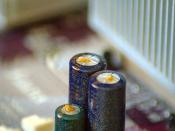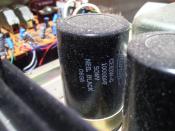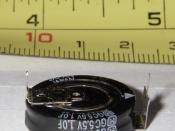A capacitor is a device designed for the purpose of storing a charge, similar to a battery, although it is unable to produce new electrons - it only stores them.
The Basics:
Like a battery, a capacitor has two terminals. Inside the capacitor, the terminals connect to two metal plates separated by a dielectric. The dielectric can be air, paper, plastic or anything else that does not conduct electricity and keeps the plates from touching each other. You can easily make a capacitor from two pieces of aluminum foil and a piece of paper. It won't be a particularly good capacitor in terms of its storage capacity, but it will work. A capacitor will pass alternating current but (apart from an initial surge) it will not pass d.c.
In an electronic circuit, a capacitor is shown like this:
When a capacitor is connected to a battery:
÷ The plate on the capacitor that attaches to the negative terminal of the battery accepts electrons that the battery is producing.
÷ The plate on the capacitor that attaches to the positive terminal of the battery loses electrons to the battery.
Once it's charged, the capacitor has the same voltage as the battery. For a small capacitor, the capacity is small and therefore large capacitors can hold quite a bit of charge. You can find capacitors as big as coke cans, which may hold enough charge to light a torch's bulb for a minute or more. Lightning is a possible example of a huge capacitor where one plate is the cloud and the other plate is the ground, and the lightning is the charge releasing between these two "plates."
If you were to create a circuit such as this:
Within this circuit, the capacitor is connected to an LED light. What you would...


